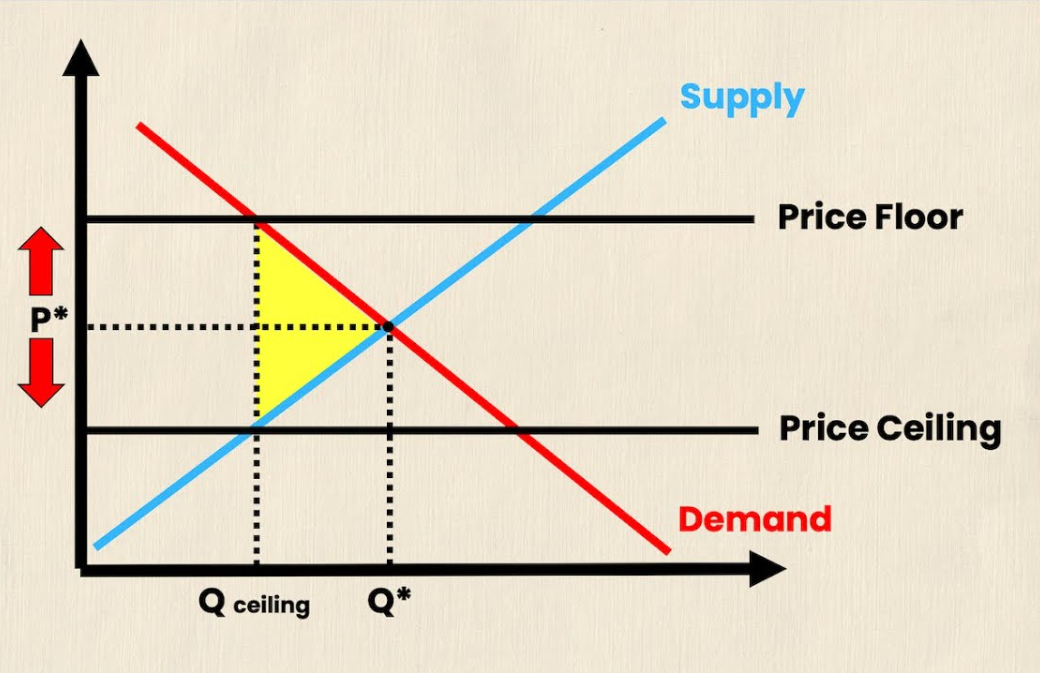Price ceiling and price floor are both price controls imposed by governments to regulate the price of goods and services in the market. These controls can have a significant impact on the equilibrium price and quantity in the market.
Government intervention in the form of Price ceiling and price floor causes market disequilibrium

Price Ceiling:
A price ceiling is a maximum legal price that can be charged for a good or service. It is set below the natural equilibrium price, which is the price where the quantity supplied equals the quantity demanded. When a price ceiling is set, the price cannot rise above this limit, even if there is high demand.
Impact on Equilibrium:
-
If the price ceiling is below the equilibrium price: A shortage occurs. At the price ceiling, the quantity demanded exceeds the quantity supplied because consumers want to buy more at the lower price, but producers are unwilling to supply as much at that price. This leads to a shortage of the good or service in the market.
-
If the price ceiling is above the equilibrium price: There is no effect on the market because the equilibrium price is already below the price ceiling. In this case, the market operates normally at the equilibrium point.
Example: Rent control in cities can be seen as a price ceiling. If the maximum rent a landlord can charge is set below the market equilibrium rent, it can lead to a shortage of rental units, as fewer landlords will be willing to rent at the lower price, and more people will be seeking affordable housing.
Black Marketing: A subsequent consequence of Price ceiling
-
In response to the shortage created by the price ceiling, black marketers take advantage of the gap between supply and demand.
-
They acquire the product (which is in limited supply due to the price ceiling) and sell it at a price above the legal price—often significantly higher than the ceiling price.
-
Black marketers typically operate outside the legal framework, selling the goods in unregulated markets or in secretive ways to avoid detection by authorities.
Price Floor:
A price floor is a minimum legal price that can be charged for a good or service. It is set above the natural equilibrium price, where the quantity demanded equals the quantity supplied. When a price floor is implemented, the price cannot fall below this minimum.
Impact on Equilibrium:
-
If the price floor is above the equilibrium price: A surplus occurs. At the price floor, the quantity supplied exceeds the quantity demanded because producers are willing to supply more at the higher price, but consumers are not willing to buy as much. This leads to a surplus of goods or services, also known as Commodity Glut in the market.
-
If the price floor is below the equilibrium price: There is no effect on the market because the equilibrium price is already above the price floor. In this case, the market operates normally at the equilibrium point.
Example: Minimum wage laws are an example of a price floor. If the government sets a minimum wage above the equilibrium wage rate for a particular job, it can lead to a surplus of labour (i.e., more people willing to work at the higher wage than there are jobs available), which can cause unemployment.
In Summary:
-
Price Ceiling (below equilibrium price) → Shortage (demand > supply) → Black Marketing
-
Price Floor (above equilibrium price) → Commodity Glut (Surplus) (supply > demand).
Both price ceiling and price floor disrupt the natural equilibrium, either causing a shortage (price ceiling) or a surplus (price floor).